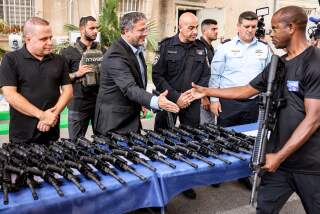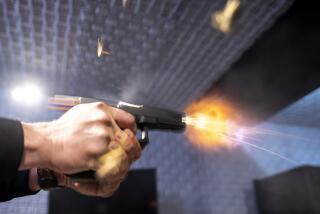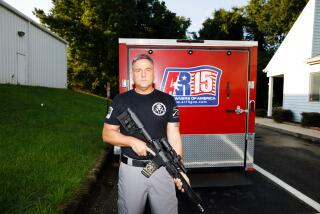U.S. rearms Iraqi soldiers for a new era
- Share via
BESMAYA RANGE, IRAQ — The company of Iraqi soldiers pressed together for the dance of valor, singing of their bravery, stomping in the desert sand, thrusting their weapons skyward, just as they might have done not so many years ago to honor Saddam Hussein.
But what were those sleek silhouettes they jabbed into the air? Not AK-47s. The iconic Soviet bloc assault rifle that has been synonymous for decades with America’s adversaries and the developing world is being phased out of the Iraqi army.
Its replacement? The M-16, a rifle that first saw service in the jungles of Vietnam and has since, over a sometimes difficult evolution, become the dominant symbol of the Western soldier.
Over the next year or two, the 190,000 projected members of the Iraqi army will be issued M-16s or related weapons, to the consternation of some military aficionados and pundits, with some saying the U.S. is tempting fate by offering the world’s premier assault rifle to a country with an unstable government and a healthy black market.
Others see a stroke of genius in giving the Iraqis a weapon renowned for its temperamental nature.
“Having an insurgent pick up and use an M-16? Possibly detrimental to their efforts in the long run,” one blogger wrote sarcastically.
The controversy reflects the two weapons’ remarkably different characteristics and their competing roles in global power struggles over the last five decades.
The AK, bred in the Soviet assembly lines of 1947, is easy to mass-produce and renowned for its indestructibility. A large round and big kick give it a “spray and pray” shooting style that fits the needs of ill-trained armies, rebel groups and warlords.
Though developed only about a decade later, the M-16 was conceived as a precision instrument, and it can be as cranky as a sewing machine. Jamming problems in the early models were resolved partly through refinements but also by strict maintenance regimes.
Already, about 10,000 of the Colt-manufactured assault rifles have been distributed to Iraqi soldiers in Baghdad and other parts of the country. The Iraqi Defense Ministry has ordered about 41,000 of the weapons, which sell for about $800 apiece, and the U.S. Army has authorized the sale of 80,000 others, plus 50,000 of the related M-4.
Now, at this training base in the desert east of Baghdad, the 3rd Brigade of the 11th Iraqi Infantry is becoming the first all-new brigade to be formed with the standard NATO weapon as its firearm.
Each day a new batch of soldiers receives the weapons, factory-wrapped in blue plastic and cardboard. At the same time, each man is scanned for biometric information to help build a database of army personnel and also make each soldier responsible for his rifle.
They spend the next three days on the range, zeroing in their sights and qualifying. About 92% make it the first time, their instructor said. They then graduate to live-fire tactical training, learning how to enter a house, identify a target and shoot to kill.
The rifle swap is part of a gradual Americanization of the Iraqi forces since the 2003 invasion. With their Soviet-made vehicles destroyed, Iraqi soldiers early on were equipped with American Humvees, on which they mounted Eastern guns. In September 2006, Congress approved $3 billion in sales of military hardware to Iraq.
But Iraqi defense officials were especially eager for the U.S. rifle to modernize their forces, Defense Ministry spokesman Mohammed Askari said.
“These weapons possess high quality and the most recent specifications that will help us in upgrading the work of our ministry,” Askari said.
After some resistance, U.S. commanders now embrace the swap as a symbol of change for what they call the new Iraqi army.
“The M-16 is a sign of the Iraqi army being a modern army,” said Brig. Gen. Robin Swan, who is in charge of the U.S.-led forces’ Iraqi training command.
Base commander Col. Abbas Fadhil, who made headlines this fall by collecting donations from his men for California fire victims, had a more graphic rationale.
“They make better to kill by being very short rounds, not big,” Abbas said.
His imperfect English left some doubt whether he was referring to the M-16’s smaller caliber or its reputedly tight firing pattern, but his intent was clear.
“One shot, one kill,” he said.
Most weapons experts agree that the M-16, with its lighter punch, high-tech sights and accurate three-shot firing burst, is most effective in the hands of disciplined soldiers in highly trained tactical units.
Not everyone is convinced that soldiers who still do the valor dance that puffed Hussein’s ego can be raised to that caliber.
“Without a wholesale change in military culture and training, the Iraqi army will not embrace the fundamentals of precision rifle marksmanship necessary to successfully employ the M-16,” commentator Philip Carter, a former Army captain and now associate in McKenna Long & Aldridge law firm, wrote on his Internet blog.
Brig. Gen. Swan contends that the weapon itself will inculcate discipline in soldiers who are eager to emulate the Americans.
“They see what our soldiers do every day,” Swan said. “There is a desire to be equipped the same.”
They’ll quickly learn that the rifle won’t work if it isn’t cleaned, he said.
Anthony Cordesman, a military analyst for the Center for Strategic and International Studies in Washington, sees the switch as a purely strategic step necessitated by the U.S. military’s realization that it is going to have a long association with the Iraqi army.
“It’s become very obvious you can’t run a major network and supply system in Iraq without the Iraqi army becoming dependent on the U.S.,” Cordesman said. “You’re going to have to equip people with the weapon the U.S. equips, supports and trains with.”
But, no matter what its strategic or tactical merits, the Iraqi army’s adoption of the M-16 is indisputably symbolic, a choice of composite over wood and iron and West over East.
The meaning was impossible to miss in the smile on the face of a 3rd Brigade recruit who had just unwrapped his new weapon and declared it “the best,” without having fired a shot.
Nothing is closer to a soldier’s soul than his rifle, said Brig. Gen. Stephen Gledhill, a Briton who is Swan’s second in command. “A soldier should love his rifle.”
And the problem with the AK-47?
“It does represent the old regime,” he said with practiced dryness.
--
Times staff writer Saif Rasheed contributed to this report.
More to Read
Sign up for Essential California
The most important California stories and recommendations in your inbox every morning.
You may occasionally receive promotional content from the Los Angeles Times.














